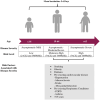COVID-19: Current knowledge in clinical features, immunological responses, and vaccine development
- PMID: 33577115
- PMCID: PMC7898934
- DOI: 10.1096/fj.202002662R
COVID-19: Current knowledge in clinical features, immunological responses, and vaccine development
Abstract
The COVID-19 pandemic has unfolded to be the most challenging global health crisis in a century. In 11 months since its first emergence, according to WHO, the causative infectious agent SARS-CoV-2 has infected more than 100 million people and claimed more than 2.15 million lives worldwide. Moreover, the world has raced to understand the virus and natural immunity and to develop vaccines. Thus, within a short 11 months a number of highly promising COVID-19 vaccines were developed at an unprecedented speed and are now being deployed via emergency use authorization for immunization. Although a considerable number of review contributions are being published, all of them attempt to capture only a specific aspect of COVID-19 or its therapeutic approaches based on ever-expanding information. Here, we provide a comprehensive overview to conceptually thread together the latest information on global epidemiology and mitigation strategies, clinical features, viral pathogenesis and immune responses, and the current state of vaccine development.
Keywords: COVID-19; SARS-CoV-2; immunity; therapy; vaccines.
© 2021 The Authors. The FASEB Journal published by Wiley Periodicals LLC on behalf of Federation of American Societies for Experimental Biology.
Conflict of interest statement
The authors declare no conflict of interest.
Figures



References
-
- WHO . Coronavirus (COVID‐19) Events as they Happen. https://www.who.int/emergencies/diseases/novel‐coronavirus‐2019/events‐a.... Accessed November 23, 2020.
-
- WHO . WHO Coronavirus Disease (COVID‐19) Dashboard. https://covid19.WHO.int/?gclid=Cj0KCQiAk53‐BRD0ARIsAJuNhps3swcAHiNCjnDRX.... Accessed January 28, 2020.
-
- Boccia S, Ricciardi W, Ioannidis JPA. What other countries can learn from italy during the COVID‐19 pandemic. JAMA Intern Med. 2020;180(7):927‐928. - PubMed
Publication types
MeSH terms
Substances
Grants and funding
LinkOut - more resources
Full Text Sources
Other Literature Sources
Medical
Miscellaneous

